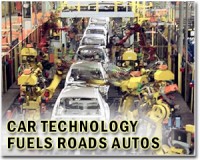 |
Munich, Germany (SPX) Aug 19, 2010 A car's crash components can spell the difference between life and death. Their job is to absorb energy in a collision in order to protect the driver inside. Researchers have now found a way for the automotive industry to mass-produce a particularly safe class of materials known as thermoplastic fiber composite components. Vehicles used to be predominantly made of steel. However, this raw material has long faced stiff competition from other materials, and modern cars are now built from a mixture of steels, aluminum and fi ber-reinforced plastics. Highly stressed load-bearing structures and crash components that are designed to buckle on impact help to reinforce the body in order to protect the vehicle's occupants in the event of a collision. Automakers have previously constructed these parts from composites using a thermoset (i.e. infusible) matrix. But this approach has a number of disadvantages: as well as being diffi cult to implement effi ciently in a mass production environment, it can also be potentially hazardous since this material tends to "delaminate" into sharp-edged splinters in a collision. A further problem is the fact that thermosets cannot be recycled. Researchers from the Fraunhofer Institute for Chemical Technology ICT in Pfi nztal have now found a solution to this problem by developing a new class of materials designed for large-scale use in vehicle construction: thermoplastic fi ber composite materials. Once they have reached the end of their useful life, they can be shredded, melted down and reused to produce high-quality parts. And they also perform signifi cantly better in crash tests: thermoplastic components reinforced with textile structures absorb the enormous forces generated in a collision through viscoelastic deformation of the matrix material - without splintering. Researchers had previously failed to come up with a suitable manufacturing technique for thermoplastic composite structures made from high performance fi bers, but the ICT engineers have now developed a process suitable for mass production which makes it possible to manufacture up to 100,000 parts a year. "Our method offers comparatively short production times," states Dieter Gittel, a project manager at ICT. "The cycle time to produce thermoplastic components is only around fi ve minutes. Comparable thermoset components frequently require more than 20 minutes." The Fraunhofer researchers have named their technique thermoplastic RTM (T-RTM). It is derived from the conventional RTM (Resin Transfer Molding) technique for thermoset fi ber composites. The composite is formed in a single step. "We insert the pre-heated textile structure into a temperature-controlled molding tool so that the fi ber structures are placed in alignment with the anticipated stress. That enables us to produce very lightweight components," Gittel explains. The preferred types of reinforcement comprise carbon or glass fi bers, and the researchers have also developed highly specialized structures. The next step involves injecting the activated monomer melt into the molding chamber. This contains a catalyst and activator system - chemical substances that are required for polymerization. The ingenious part is that the researchers can select the system and the processing temperature in a way that enables them to set the minimum required processing time. A demonstration part has confi rmed the benefi ts of this new class of material: the trunk liner for the Porsche "Carrera 4" weighs up to 50 percent less than the original aluminum part. To improve the crash behavior of the vehicle's overall structure, the ICT engineers also calculated the optimum fi ber placement. Another advantage of the T-RTM process is that the cost of the thermoplastic matrix material and the cost of its processing are up to 50 percent lower than the equivalent costs for thermoset structures. Over the next few years it is anticipated that these kinds of components will start to be used in vehicle and machine construction as well as in the leisure industry.
Share This Article With Planet Earth
Related Links Fraunhofer-Institute Car Technology at SpaceMart.com
 Scientists develop safer parts for cars
Scientists develop safer parts for carsPfinztal, Germany (UPI) Aug 18, 2010 German researchers say they've developed a way to mass-produce a safer class of materials for use in automobile crash components. Materials known as thermoplastic fiber composites could replace less-suitable materials in stressed load-bearing structures and crash components in automobiles, the Fraunhofer-Institute for Chemical Technology said in a release Wednesday. Automakers ha ... read more |
|
| The content herein, unless otherwise known to be public domain, are Copyright 1995-2010 - SpaceDaily. AFP and UPI Wire Stories are copyright Agence France-Presse and United Press International. ESA Portal Reports are copyright European Space Agency. All NASA sourced material is public domain. Additional copyrights may apply in whole or part to other bona fide parties. Advertising does not imply endorsement,agreement or approval of any opinions, statements or information provided by SpaceDaily on any Web page published or hosted by SpaceDaily. Privacy Statement |